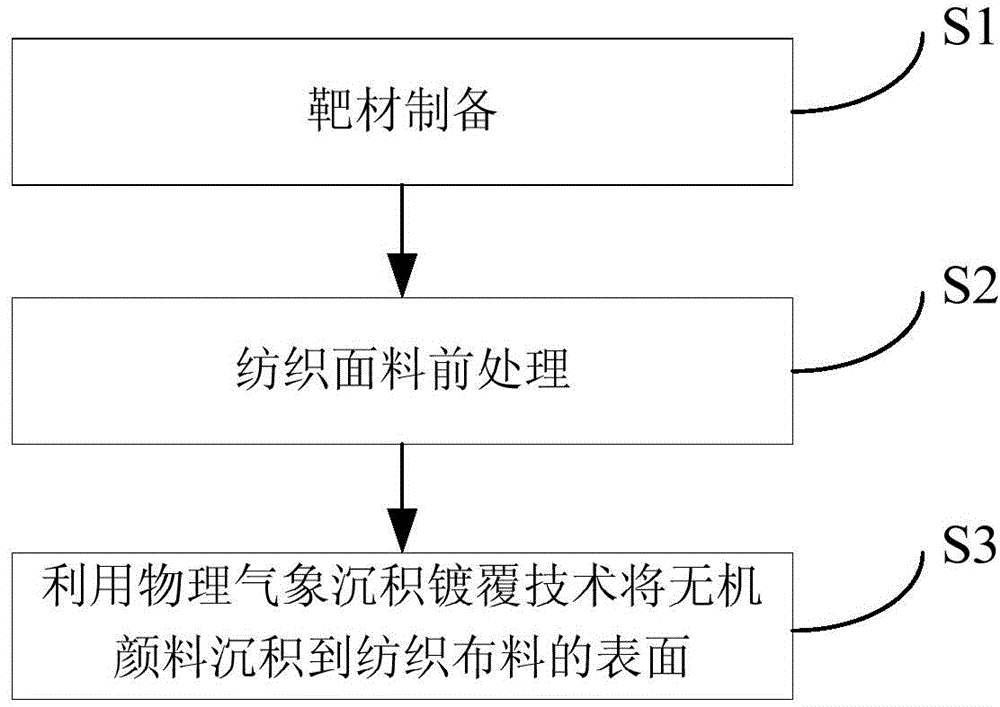Textile anhydrous coloring method
A technology for textiles and textile fabrics, which is applied in the fields of textile printing and dyeing and physical vapor deposition plating, can solve the problems of less research on textile coloring, low textile coloring strength, etc., and achieves high pigment utilization rate, easy mass production, and simple and convenient process. Effect
- Summary
- Abstract
- Description
- Claims
- Application Information
AI Technical Summary
Problems solved by technology
Method used
Image
Examples
specific Embodiment approach 1
[0031] The specific process of electron beam evaporation textile coloring is as follows:
[0032] (1) Target preparation:
[0033] Pour the powdered iron oxide red into a mold with a diameter of Φ10mm, and press the above-mentioned luminescent material (that is, the powdered iron oxide red) for 1 minute with a 3855 American CARVER manual standard tablet press under a static pressure of 10 tons. A circular pie-shaped evaporation target material was obtained with a thickness of about 2 mm.
[0034] The vapor deposition target prepared by this method has sufficient pressing force, so it can be used without annealing and sintering, and the process is simple and efficient.
[0035] (2) Pre-treatment of textile fabrics:
[0036] Select a polyester white cloth with a size of 40mm×40mm as the textile fabric, select a textile as the textile fabric, wash it with absolute ethanol, acetone and deionized water in sequence, and then dry it at 70°C-90°C for 24 hours to remove excess water....
specific Embodiment approach 2
[0041] The specific process flow of intermediate frequency twin target sputtering coating textile coloring is as follows:
[0042] (1) Target preparation:
[0043] The yellow iron oxide powder was pressed and sintered into two rectangular sputtering targets with a size of 900*120*12mm.
[0044] (2) Pre-treatment of textile fabrics:
[0045] Clean the pure cotton white cloth with a width of 600mm that has been scoured and bleached with absolute ethanol, acetone and deionized water in sequence, and put it in an oven to dry for 24 hours to remove excess water. The temperature of the oven is 70°C-90°C, preferably is 80°C.
[0046] (3) Sputtering coating:
[0047] Install the dried polyester white cloth and the fired intermediate frequency twin target on the textile winding coating machine to carry out color coating on the textile.
[0048] (4) Colored textiles are packed in rolls.
[0049] It has been tested that the textile color cloth prepared by the method of the second em...
specific Embodiment approach 3
[0050] The specific process of electron beam evaporation textile coloring is as follows:
[0051] (1) Target preparation:
[0052] Pour the natural mineral pigment cinnabar into a mold with a diameter of Φ10mm, and use a 3855 American CARVER standard manual tablet press to press the above pigment for 1 minute under a static pressure of 10 tons to obtain a circular cake-shaped evaporation target. Its thickness is about 2 mm.
[0053] The vapor deposition target prepared by this method has sufficient pressing force, so it can be used without annealing and sintering, and the process is simple and efficient.
[0054] (2) Pre-treatment of textile fabrics:
[0055] A polyester white cloth with a size of 40mm×40mm was selected as the textile fabric, washed with absolute ethanol, acetone and deionized water in sequence, and then dried in an oven at 80°C for 24 hours to remove excess water.
[0056] (3) Electron beam evaporation coating deposition:
[0057] Install the dried polyeste...
PUM
| Property | Measurement | Unit |
|---|---|---|
| Thickness | aaaaa | aaaaa |
Abstract
Description
Claims
Application Information
 Login to View More
Login to View More - R&D Engineer
- R&D Manager
- IP Professional
- Industry Leading Data Capabilities
- Powerful AI technology
- Patent DNA Extraction
Browse by: Latest US Patents, China's latest patents, Technical Efficacy Thesaurus, Application Domain, Technology Topic, Popular Technical Reports.
© 2024 PatSnap. All rights reserved.Legal|Privacy policy|Modern Slavery Act Transparency Statement|Sitemap|About US| Contact US: help@patsnap.com








